China
| China | |||
|---|---|---|---|
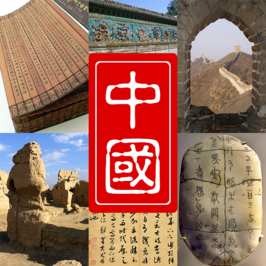 | |||
| | |||
| Traditional Chinese: | 中國 | ||
| Simplified Chinese: | 中国 | ||
| |||
| | This article contains Chinese text. Without proper rendering support, you may see question marks, boxes, or other symbols instead of Chinese characters. |
With nearly 4,000 years of continuous history, China is one of the world's oldest civilizations.[1][2][3] Prior to the 19th century, it possessed one of the most advanced societies and economies in the world; but through successive dynasties it then missed the Industrial Revolution and began to decline.[4][5] In the 19th and 20th century, imperialism, internal weakness and civil wars damaged the country and its economy, and led to the overthrow of imperial rule.
In 1949, after major combat ended in the Chinese Civil War, two states calling themselves "China" emerged:
 The People's Republic of China (PRC), established in 1949, commonly known as China, has control over mainland China and the largely self-governing territories of Hong Kong (since 1997) and Macau (since 1999).
The People's Republic of China (PRC), established in 1949, commonly known as China, has control over mainland China and the largely self-governing territories of Hong Kong (since 1997) and Macau (since 1999). The Republic of China (ROC) established in 1912 in mainland China, now commonly known as Taiwan, has control over the islands of Taiwan, Penghu, Kinmen, Matsu, the Pratas island group, and a few other outlying islands.
The Republic of China (ROC) established in 1912 in mainland China, now commonly known as Taiwan, has control over the islands of Taiwan, Penghu, Kinmen, Matsu, the Pratas island group, and a few other outlying islands.
Historically, cultural sphere of China has extended across East Asia as a whole, with Chinese religion, customs, and writing systems being adopted to varying degrees by neighbors such as Japan, Korea and Vietnam. Through its history, China was the source of many major inventions.[9] It has also one of the world's oldest written language systems. The first evidence of human presence in the region was found at the Zhoukoudian cave. It is one of the earliest known specimens of Homo erectus, now commonly known as the Peking Man, estimated to have lived from 300,000 to 780,000 years ago.[10][11][12]
Contents[hide] |
Etymology
Main article: Names of China

The traditional (top) and simplified (bottom) characters for "China" in Chinese. The first character means "middle" or "center", and the second character means "country".
English names
The word "China" is derived from Cin (چین), a Persian name for China popularized in Europe by Marco Polo.[13][14] The first recorded use in English dates from 1555.[15] In early usage, "china" as a term for porcelain was spelled differently from the name of the country, the two words being derived from separate Persian words.[16] Both these words are derived from the Sanskrit word Cīna (चीन),[16] used as a name for China as early as AD 150.[17]There are various scholarly theories regarding the origin of this word. The traditional theory, proposed in the 17th century by Martino Martini, is that "China" is derived from "Qin" (秦, pronounced chin), the westernmost of the Chinese kingdoms during the Zhou Dynasty, or from the succeeding Qin Dynasty (221 – 206 BC).[18] In the Hindu scriptures Mahābhārata (5th century BC)[19] and Manusmṛti (Laws of Manu) (2nd century BC), the Sanskrit word Cīna (चीन) is used to refer to a country located in the Tibeto-Burman borderlands east of India.[20] Another theory is that this word is derived from Yelang, an ancient kingdom in what is now Guizhou whose inhabitants referred to themselves as 'Zina'.[21]
Chinese names
The official name of China changed with each dynasty or with each new government, the imperial governments referred to themselves as the Empire of the Great Qing, Empire of the Great Ming, etc. However, the common name remained as Zhōngguó (simplified Chinese: 中国; traditional Chinese: 中國, Mandarin pronunciation: [tʂʊ́ŋkwɔ̌]) through dynastic changes. This translates traditionally as "Middle Kingdom," or as "central country."The name Zhōngguó first appeared in the Classic of History (6th century BC), and was used to refer to the late Zhou Dynasty, as they believed that they were the "center of civilization,"[nb 1] while peoples in the four cardinals were called Eastern Yi, Southern Man, Western Rong and Northern Di respectively. Some texts imply that "Zhōngguó" was originally meant to refer to the capital of the sovereign, to differ from the capital of his vassals.[nb 2] The use of "Zhōngguó" implied a claim of political legitimacy, and "Zhōngguó" was often used by states who saw themselves as the sole legitimate successor to previous Chinese dynasties; for example, in the era of the Southern Song Dynasty, both the Jin Dynasty and the Southern Song state claimed to be "Zhōngguó."[nb 3]
Zhōngguó was used as a common name for the Republic of China (Zhonghua Minguo) after its establishment in 1912. After the Communists took over control of China in 1949, they established the People's Republic of China (PRC). As a result, the PRC is now commonly known as "China" or "Zhōngguó". The Republic of China nowadays is commonly known as "Taiwan".[nb 4]
History
Main articles: History of China and Timeline of Chinese history
| History of China | |||||||
|---|---|---|---|---|---|---|---|
| ANCIENT | |||||||
| 3 Sovereigns and 5 Emperors | |||||||
| Xia Dynasty 2100–1600 BCE | |||||||
| Shang Dynasty 1600–1046 BCE | |||||||
| Zhou Dynasty 1045–256 BCE | |||||||
| Western Zhou | |||||||
| Eastern Zhou | |||||||
| Spring and Autumn Period | |||||||
| Warring States Period | |||||||
| IMPERIAL | |||||||
| Qin Dynasty 221 BCE–206 BCE | |||||||
| Han Dynasty 206 BCE–220 CE | |||||||
| Western Han | |||||||
| Xin Dynasty | |||||||
| Eastern Han | |||||||
| Three Kingdoms 220–280 | |||||||
| Wei, Shu & Wu | |||||||
| Jin Dynasty 265–420 | |||||||
| Western Jin | 16 Kingdoms 304–439 | ||||||
| Eastern Jin | |||||||
| Southern & Northern Dynasties 420–589 | |||||||
| Sui Dynasty 581–618 | |||||||
| Tang Dynasty 618–907 | |||||||
| ( Second Zhou 690–705 ) | |||||||
| 5 Dynasties & 10 Kingdoms 907–960 | Liao Dynasty 907–1125 | ||||||
| Song Dynasty 960–1279 | |||||||
| Northern Song | W. Xia | ||||||
| Southern Song | Jin | ||||||
| Yuan Dynasty 1271–1368 | |||||||
| Ming Dynasty 1368–1644 | |||||||
| Qing Dynasty 1644–1911 | |||||||
| MODERN | |||||||
| Republic of China 1912–present | |||||||
| People's Republic of China 1949–present | Republic of China (Taiwan) 1912–present | ||||||
Prehistory
Archaeological evidence suggests that the earliest hominids in China date from 250,000 to 2.24 million years ago.[23][24] A cave in Zhoukoudian (near present-day Beijing) has fossils dated at somewhere between 300,000 to 780,000 years.[10][11][12] The fossils are of Peking Man, an example of Homo erectus who used fire.The earliest evidence of a fully modern human in China comes from Liujiang County, Guangxi, where a cranium has been found and dated at approximately 67,000 years old. Although much controversy persists over the dating of the Liujiang remains,[25][26] a partial skeleton from Minatogawa in Okinawa, Japan has been dated to 16,600 to 18,250 years old, so modern humans probably reached China before that time.[citation needed]
Dynastic rule
Main articles: Dynasties in Chinese history and Chinese sovereign
The first Chinese dynasty that left historical records, the loosely feudal Shang (Yin), settled along the Yellow River in eastern China from the 17th to the 11th century BC. The Oracle bone script of the Shang Dynasty represent the oldest forms of Chinese writing found and the direct ancestor of modern Chinese characters used throughout East Asia. The Shang were invaded from the west by the Zhou, who ruled from the 12th to the 5th century BC, until their centralized authority was slowly eroded by feudal warlords. Many independent states eventually emerged out of the weakened Zhou state, and continually waged war with each other in the Spring and Autumn Period, only occasionally deferring to the Zhou king. By the time of the Warring States Period, there were seven powerful sovereign states, each with its own king, ministry and army.
The first unified Chinese state was established by Qin Shi Huang of the Qin state in 221 BC, who proclaimed himself as the "First Emperor" and created many reforms in the Empire, notably the forced standardization of the Chinese language and measurements. The Qin Dynasty lasted only fifteen years, as its harsh legalist and authoritarian policies soon led to widespread rebellion.
The subsequent Han Dynasty ruled China between 206 BC and 220 AD, and created a lasting Han cultural identity among its populace that extends to the present day. The Han Dynasty expanded the empire's territory considerably with military campaigns reaching Korea, Vietnam, Mongolia and Central Asia, and also helped establish the Silk Road in Central Asia.
After Han's collapse, another period of disunion followed, including the highly chivalric period of the Three Kingdoms. Independent Chinese states of this period such as Wu opened diplomatic relations with Japan, introducing the Chinese writing system there. In 580 AD, China was reunited under the Sui. However, the Sui Dynasty was short-lived after a failure in the Goguryeo-Sui Wars (598–614) weakened it.

10th–11th century Longquan celadon porcelain pieces from Zhejiang province, during the Song Dynasty.
Within its borders, the Northern Song Dynasty had a population of some 100 million people. The Song Dynasty was a culturally rich period for philosophy and the arts. Landscape art and portrait painting were brought to new levels of maturity and complexity after the Tang Dynasty, and social elites gathered to view art, share their own, and trade precious artworks. Philosophers such as Cheng Yi and Chu Hsi reinvigorated Confucianism with new commentary, infused Buddhist ideals, and emphasized a new organization of classic texts that brought about the core doctrine of Neo-Confucianism.
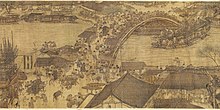
Along the River During the Qingming Festival; daily life of people from the Song period at the capital, Bianjing, today's Kaifeng.
Under the Ming Dynasty, China had another golden age, with one of the strongest navies in the world, a rich and prosperous economy and a flourishing of the arts and culture. It was during this period that Zheng He led explorations throughout the world, possibly reaching America. During the early Ming Dynasty China's capital was moved from Nanjing to Beijing. In 1644 Beijing was sacked by a coalition of rebel forces led by Li Zicheng, a minor Ming official turned leader of the peasant revolt. The last Ming Emperor Chongzhen committed suicide when the city fell. The Manchu Qing Dynasty then allied with Ming Dynasty general Wu Sangui and overthrew Li's short-lived Shun Dynasty, and subsequently seized control of Beijing, which became the new capital of the Qing dynasty.
The Qing Dynasty, which lasted until 1912, was the last dynasty in China. In the 19th century the Qing Dynasty adopted a defensive posture towards European imperialism, even though it engaged in imperialistic expansion into Central Asia. At this time China awoke to the significance of the rest of the world, the West in particular. As China opened up to foreign trade and missionary activity, opium produced by British India was forced onto Qing China. Two Opium Wars with Britain weakened the Emperor's control. European imperialism proved to be disastrous for China:
The Arrow War (1856–1860) [2nd Opium War] saw another disastrous defeat for China. The subsequent passing of the humiliating Treaty of Tianjin in 1856 and the Beijing Conventions of 1860 opened up more of the country to foreign penetrations and more ports for their vessels. Hong Kong was ceded over to the British. Thus, the "unequal treaties system" was established. Heavy indemnities had to be paid by China, and more territory and control were taken over by the foreigners.[30]The weakening of the Qing regime, and the apparent humiliation of the unequal treaties in the eyes of the Chinese people had several consequences. One consequence was the Taiping Civil War, which lasted from 1851 to 1862. It was led by Hong Xiuquan, who was partly influenced by an idiosyncratic interpretation of Christianity. Hong believed himself to be the son of God and the younger brother of Jesus. Although the Qing forces were eventually victorious, the civil war was one of the bloodiest in human history, costing at least 20 million lives (more than the total number of fatalities in the World War I), with some estimates of up to two hundred million. Other costly rebellions followed the Taiping Rebellion, such as the Punti-Hakka Clan Wars (1855–67), Nien Rebellion (1851–1868), Muslim Rebellion (1862–77), Panthay Rebellion (1856–1873) and the Miao Rebellion (1854–73).[31][32]

A corner tower of the Forbidden City at night; the palace was the residence for the imperial family from the reign of the Yongle Emperor of the Ming Dynasty in the 15th century until the fall of the Qing Dynasty in 1912.
While China was wracked by continuous war, Meiji Japan succeeded in rapidly modernizing its military and set its sights on Korea and Manchuria. At the request of the Korean emperor, the Chinese government sent troops to aid in suppressing the Tonghak Rebellion in 1894. However, Japan also sent troops to Korea, leading to the First Sino-Japanese War, which resulted in Qing China's loss of influence in the Korean Peninsula as well as the cession of Taiwan to Japan.
Following this series of defeats, a reform plan for the empire to become a modern Meiji-style constitutional monarchy was drafted by the Guangxu Emperor in 1898, but was opposed and stopped by the Empress Dowager Cixi, who placed Emperor Guangxu under house arrest in a coup d'état. Further destruction followed the ill-fated 1900 Boxer Rebellion against westerners in Beijing.
By the early 20th century, mass civil disorder had begun, and calls for reform and revolution were heard across the country. The 38-year-old Emperor Guangxu died under house arrest on 14 November 1908, suspiciously just a day before Cixi's own death. With the throne empty, he was succeeded by Cixi's handpicked heir, his two year old nephew Puyi, who became the Xuantong Emperor. Guangxu's consort, who became the Empress Dowager Longyu. In another coup de'tat, Yuan Shikai overthrew the last Qing emperor, and forced empress Dowager Longyu to sign the abdication decree as regent in 1912, ending two thousand years of imperial rule in China. She died, childless, in 1913.
Republic of China (1912–49)
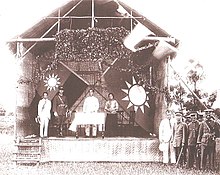
Sun Yat-sen and Chiang Kai-shek at the founding of the Whampoa Military Academy. Flags of the Republic of China and the Nationalist Party shown.
Main article: History of the Republic of China
On 1 January 1912, the Republic of China was established, heralding the end of the Qing Dynasty. Sun Yat-sen of the Kuomintang (the KMT or Nationalist Party) was proclaimed provisional president of the republic. However, the presidency was later given to Yuan Shikai, a former Qing general, who had ensured the defection of the entire Beiyang Army from the Qing Empire to the revolution. In 1915, Yuan proclaimed himself Emperor of China but was forced to abdicate and return the state to a republic when he realized it was an unpopular move, not only with the population but also with his own Beiyang Army and its commanders.After Yuan Shikai's death in 1916, China was politically fragmented, with an internationally recognized but virtually powerless national government seated in Peking (Beijing). Warlords in various regions exercised actual control over their respective territories. In the late 1920s, the Kuomintang, under Chiang Kai-shek, was able to reunify the country under its own control, moving the nation's capital to Nanking (Nanjing) and implementing "political tutelage", an intermediate stage of political development outlined in Sun Yat-sen's program for transforming China into a modern, democratic state. Effectively, political tutelage meant one-party rule by the Kuomintang.
The Second Sino-Japanese War (1937-1945) (part of World War II) forced an uneasy alliance between the Nationalists and the Communists as well as causing around 20 million Chinese civilian deaths.[40] With the surrender of Japan in 1945, China emerged victorious but financially drained. The continued distrust between the Nationalists and the Communists led to the resumption of the Chinese Civil War. In 1947, constitutional rule was established, but because of the ongoing Civil War many provisions of the ROC constitution were never implemented in mainland China.
People's Republic of China & Post Civil War (1949–present)
Main articles: History of the People's Republic of China and Republic of China on Taiwan
After its victory in the Chinese Civil War, the Communist Party of China (CPC) led by Mao Zedong gained control of most of Mainland China. On 1 October 1949, they established the People's Republic of China as a socialist state headed by a "Democratic Dictatorship" with the CPC as the ruling political party, thus, laying claim as the successor state of the ROC. The central government of the Chinese Nationalist Party led by Chiang Kai-shek retreated to the island of Taiwan that it had administered at the end of World War II, and moved the ROC government there. Major armed hostilities ceased in 1950 but no peace treaty has been signed.Beginning in the late 1970s, the Republic of China began the implementation of full, multi-party, representative democracy in the territories still under its control (Taiwan, and a number of smaller islands including Quemoy and Matsu). Today, the ROC has active political participation by all sectors of society. The main cleavage in ROC politics is the issue of eventual political unification with the Chinese mainland vs. formal independence of Taiwan.
After the Chinese Civil War, mainland China saw a dramatic improvement on life expectancy, leading to an explosion in population.[41][42][43] A series of disruptive socioeconomic movements started in the late 1950s with the Great Leap Forward and continued in the 1960s with the Cultural Revolution. The Great Chinese Famine resulted in an estimated 30 to 36 million deaths.[44][45] With the death of its first generation Communist Party leaders such as Mao Zedong and Zhou Enlai, the PRC began implementing a series of political and economic reforms advocated by Deng Xiaoping that eventually formed the foundation for mainland China's rapid economic development starting in the 1990s.
Post-1978 reforms in mainland China have led to some relaxation of control over many areas of society. However, the PRC government still has almost absolute control over politics, and it continually seeks to eradicate what it perceives as threats to the social, political and economic stability of the country. Examples include the fight against terrorism, jailing of political opponents and journalists, custody regulation of the press, regulation of religion, and suppression of independence/secessionist movements. In 1989, the student protests at Tiananmen Square were violently put to an end by the Chinese military after 15 days of martial law. In 1997, Hong Kong was ceded to the PRC by the United Kingdom, and in 1999, Macau was handed over by Portugal.
Since 1949, mainland China is administered by the People's Republic of China—a one-party state under the leadership of the Chinese Communist Party—while the island of Taiwan and surrounding islands are administered by the Republic of China—a democratic multi-party state. After the founding of the People's Republic in 1949, both states claimed to be the sole legitimate ruler of all of China. After the Kuomintang retreat to Taiwan in 1949, the Republic of China had maintained official diplomatic relations with most states around the world, but by the 1970s, a shift had occurred in international diplomatic circles and the People's Republic of China gained the upper hand in international diplomatic relations and recognition count.
In 1971, under UN resolution 2758, the representatives of Chiang Kai-shek to the United Nations were expelled from the intergovernmental organization. With the expulsion of the representatives, and effectively the Republic of China, the representatives of the People's Republic of China were invited to assume China's seat on the UN Security Council, the UN General Assembly and other United Nations councils and agencies. Later attempts by the Republic of China to rejoin the UN have either been blocked by the People's Republic of China, which has veto power on the UN Security Council, or rejected by the United Nations Secretariat or a United Nations General Assembly committee responsible for the General Assembly's agenda.[46]
Since the relocation of its capital to Taiwan, the Republic of China has not formally renounced its claim to authority over all of China, nor has it changed its official maps, which include the mainland and Mongolia. Following the introduction of full democracy, and the electoral victory of the DPP's Chen Shui-bian in the presidential elections, the ROC had adopted a policy of separating the state's identity from "China", while moving towards identifying the state as "Taiwan".

Modern Nanjing skyline. China is the world's fastest-growing major economy.
Over the last 50 years, both the Republic of China and the People's Republic of China have used diplomatic and economic means to compete for recognition in the international arena. Because most international, intergovernmental organizations observe the One-China policy of the People's Republic of China, the PRC has been able to pressure organizations, such as the World Health Organization and the International Olympic Committee, to refuse to officially recognize the Republic of China. Due to the One-China policy, states around the world are pressured to refuse, or to cut off diplomatic relations with the Republic of China. As a result, 23 U.N. member states currently maintain official diplomatic relations with the Republic of China, while the vast majority of U.N. member states maintain official diplomatic relations with the People's Republic of China.
Territory and environment
Historical political divisions
Main article: History of the administrative divisions of China
Most Chinese dynasties were based in the historical heartlands of China, known as China proper. Various dynasties also expanded into peripheral territories like Inner Mongolia, Manchuria, Xinjiang, and Tibet. The Manchu-established Qing Dynasty and its successors, the ROC and the PRC, incorporated these territories into the Chinese empire.
Geography and climate
Main article: Geography of China
China ranges from mostly plateaus and mountains in the west to lower lands in the east. Principal rivers flow from west to east, including the Yangtze (central), the Huang He (Yellow river, north-central), and the Amur (northeast), and sometimes toward the south (including the Pearl River, Mekong (river), and Brahmaputra), with most Chinese rivers emptying into the Pacific Ocean.In the east, along the shores of the Yellow Sea and the East China Sea there are extensive and densely populated alluvial plains. On the edges of the Inner Mongolian plateau in the north, grasslands can be seen. Southern China is dominated by hills and low mountain ranges. In the central-east are the deltas of China's two major rivers, the Huang He and Yangtze River. Most of China's arable lands lie along these rivers, and they were the centers of China's major ancient civilizations. Other major rivers include the Pearl River, Mekong, Brahmaputra and Amur. Yunnan Province is considered a part of the Greater Mekong Subregion, which also includes Myanmar, Laos, Thailand, Cambodia, and Vietnam.[48]
In the west, the north has a great alluvial plain, and the south has a vast calcareous tableland traversed by hill ranges of moderate elevation, and the Himalayas, containing Earth's highest point, Mount Everest. The northwest also has high plateaus with more arid desert landscapes such as the Takla-Makan and the Gobi Desert, which has been expanding. During many dynasties, the southwestern border of China has been the high mountains and deep valleys of Yunnan, which separate modern China from Burma, Laos and Vietnam.
The Paleozoic formations of China, excepting only the upper part of the Carboniferous system, are marine, while the Mesozoic and Tertiary deposits are estuarine and freshwater, or else of terrestrial origin. Groups of volcanic cones occur in the Great Plain of north China. In the Liaodong and Shandong Peninsulas, there are basaltic plateaus.
The climate of China varies greatly. The northern zone (containing Beijing) has summer daytime temperatures of more than 30 degrees Celsius and winters of Arctic severity. The central zone (containing Shanghai) has a temperate continental climate with very hot summers and cold winters. The southern zone (containing Guangzhou) has a subtropical climate with very hot summers and mild winters.
Due to a prolonged drought and poor agricultural practices, dust storms have become usual in the spring in China.[49] Dust has blown to southern Mainland China and Taiwan, and has reached the West Coast of the United States. Water, erosion, and pollution control have become important issues in China's relations with other countries.
Economy
Main article: Economic history of China
See also: Economy of the People's Republic of China, Economy of the Republic of China, Economy of the Han Dynasty, Economy of the Song Dynasty, and Economy of the Ming Dynasty
Many analysts assert that China is one of the leading examples of state capitalism in the 21st century.[50][51][52]Culture
Main article: Culture of China
Confucianism was the official philosophy throughout most of Imperial China's history, and mastery of Confucian texts was the primary criterion for entry into the imperial bureaucracy. China's traditional values were derived from various versions of Confucianism. A number of more authoritarian strains of thought have also been influential, such as Legalism.There was often conflict between the philosophies, e.g. the Song Dynasty Neo-Confucians believed Legalism departed from the original spirit of Confucianism. Examinations and a culture of merit remain greatly valued in China today. In recent years, a number of New Confucians (not to be confused with Neo-Confucianism) have advocated that democratic ideals and human rights are quite compatible with traditional Confucian "Asian values".[53]
With the rise of European economic and military power beginning in the mid-19th century, non-Chinese systems of social and political organization gained adherents in China. Some of these would-be reformers totally rejected China's cultural legacy, while others sought to combine the strengths of Chinese and European cultures. In essence, the history of 20th-century China is one of experimentation with new systems of social, political, and economic organization that would allow for the reintegration of the nation in the wake of dynastic collapse.
Arts, scholarship, and literature
Main article: Chinese art
See also: Chinese literature, Chinese painting, Chinese paper art, Chinese calligraphy, Chinese poetry, Cinema of China, and Music of China

A bamboo book copy of Sun Tzu's The Art of War, a 20th century reprint of a Qianlong imperial edition.
Calligraphy later became commercialized, and works by famous artists became prized possessions. Chinese literature has a long past; the earliest classic work in Chinese, the I Ching or "Book of Changes" dates to around 1000 BC. A flourishing of philosophy during the Warring States Period produced such noteworthy works as Confucius's Analects and Laozi's Tao Te Ching. (See also: the Chinese classics.) Dynastic histories were often written, beginning with Sima Qian's seminal Records of the Historian, which was written from 109 BC to 91 BC.
The Tang Dynasty witnessed a poetic flowering, while the Four Great Classical Novels of Chinese literature were written during the Ming and Qing Dynasties. Printmaking in the form of movable type was developed during the Song Dynasty. Academies of scholars sponsored by the empire were formed to comment on the classics in both printed and handwritten form. Royalty frequently participated in these discussions as well.
The Song Dynasty was also a period of great scientific literature, and saw the creation of works such as Su Song's Xin Yixiang Fayao and Shen Kuo's Dream Pool Essays. There were also enormous works of historiography and large encyclopedias, such as Sima Guang's Zizhi Tongjian of 1084 AD or the Four Great Books of Song fully compiled and edited by the 11th century.
For centuries, religious and social advancement in China could be achieved through high performance on the imperial examinations. This led to the creation of a meritocracy, although success was available only to males who could afford test preparation. Imperial examinations required applicants to write essays and demonstrate mastery of the Confucian classics. Those who passed the highest level of the exam became elite scholar-officials known as jinshi, a highly esteemed socio-economic position.
Chinese philosophers, writers and poets were highly respected and played key roles in preserving and promoting the culture of the empire. Some classical scholars, however, were noted for their daring depictions of the lives of the common people, often to the displeasure of authorities.The Chinese invented numerous musical instruments, such as the zheng (zither with movable bridges), qin (bridgeless zither), sheng (free reed mouth organ), and xiao (vertical flute) and adopted and developed others such the erhu (alto fiddle or bowed lute) and pipa (pear-shaped plucked lute), many of which later spread throughout East Asia and Southeast Asia, particularly to Japan, Korea, and Vietnam.
Demography
Main articles: Demographics of the People's Republic of China, Ethnic groups in Chinese history, and Ethnic minorities in China
Hundreds of ethnic groups have existed in China throughout its history. The largest ethnic group in China by far is the Han. This group, however, is internally diverse and can be further divided into smaller ethnic groups that share similar traits.Over the last three millennia, many previously distinct ethnic groups in China have been Sinicized into a Han identity, which over time dramatically expanded the size of the Han population. However, these assimilations were usually incomplete, and vestiges of indigenous language and culture still often remain in various regions of China. Because of this, many within the Han identity have maintained distinct linguistic and cultural traditions while still identifying as Han.
Several ethnicities have also dramatically shaped Han culture, e.g. the Manchurian clothing called the qipao became the new "Chinese" fashion after the 17th century, replacing earlier Han styles of clothing such as the Hanfu. The modern term Chinese nation (Zhonghua Minzu) is now used to describe a notion of a Chinese nationality that transcends ethnic divisions.
Languages
Main article: Languages of China
Most languages in China belong to the Sino-Tibetan language family, spoken by 29 ethnicities. There are also several major linguistic groups within the Chinese language itself. The most spoken varieties are Mandarin (spoken by over 70% of the population), Wu, Yue (Cantonese), Min, Xiang, Gan, and Hakka. Non-Sinitic languages spoken widely by ethnic minorities include Zhuang (Thai), Mongolian, Tibetan, Uyghur (Turkic), Hmong and Korean.[54]Classical Chinese was the written standard in China for thousands of years, and allowed for written communication between speakers of various unintelligible languages and dialects in China. Vernacular Chinese or baihua is the written standard based on the Mandarin dialect first popularized in Ming dynasty novels, and was adopted (with significant modifications) during the early 20th century as the national vernacular. Classical Chinese is still part of the high school curriculum and is thus intelligible to some degree to many Chinese.
Religion
Main article: Religion in China
The "official" orthodox faith system held by most dynasties of China since at least the Shang Dynasty (1766 BC) until the overthrow of the last dynasty (1911 AD) centered on the worship of Shangdi ("Supreme God") or "Heaven" as an omnipotent force.[55] This faith system pre-dated the development of Confucianism and Taoism and the introduction of Buddhism, Islam and Christianity.It has features of monotheism in that Heaven is seen as an omnipotent entity, endowed with personality but no corporeal form. From the writings of Confucius, we find that Confucius himself believed that Heaven cannot be deceived, Heaven guides people's lives and maintains a personal relationship with them, and that Heaven gives tasks for people to fulfill to teach them righteousness (yi, 義).[55] However, this faith system was not truly monotheistic since other lesser gods and spirits, which varied with locality, were also worshiped along with Shangdi. Still, variants such as Mohism approached high monotheism, teaching that the function of lesser gods and ancestral spirits is merely to carry out the will of Shangdi, which included observing "universal love" (jian'ai, 兼爱) and shunning fatalism.
Worship of Shangdi and Heaven in ancient China includes the erection of shrines, the last and greatest being the Temple of Heaven in Beijing, and the offering of prayers. The ruler of China in every Chinese dynasty would perform annual sacrificial rituals to Heaven, usually by slaughtering a bull as sacrifice. Although its popularity gradually diminished after the advent of Taoism and Buddhism, among other religions, its concepts remained in use throughout the pre-modern period and have been incorporated in later religions in China, including terminology used in Chinese Christianity.

The Round Mound Altar, the altar proper at the Temple of Heaven in Beijing, where the Emperor communed with Heaven
Buddhism in China was first introduced from India and Central Asia during the Han dynasty and became very popular among Chinese of all walks of life, embraced particularly by commoners, and sponsored by emperors in certain dynasties. Mahayana (Dacheng, 大乘) is the predominant form of Buddhism practiced in China, where it was largely Sinicized and later exported to Korea, Japan and Vietnam. Some subsets of Mahayana popular in China include Pure Land (Amidism) and Zen. Buddhism is the largest organized faith in China and the country has the most Buddhist adherents in the world. Many Chinese, however, identify themselves as both Taoist and Buddhist at the same time.
Ancestor worship is a major religious theme shared among all Chinese religions. Traditional Chinese culture, Taoism, Confucianism, and Chinese Buddhism all value filial piety, or a love and respect for one's parents and ancestors, as one of the most important virtues. Chinese people generally offer prayers and food for their ancestors, light incense and candles, and burn offerings of Joss paper. These activities are typically conducted at the site of ancestral graves or tombs, at an ancestral temple, or at a household shrine.
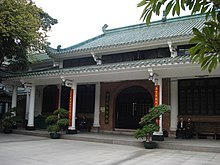
The Huaisheng Mosque is one of the oldest Mosques in the world, built by Muhammad's uncle, Sa`d ibn Abi Waqqas
Judaism in China dates to as early as the 7th or 8th century CE. In the first half of the 20th century, many Jews arrived in Shanghai and Hong Kong during those cities' periods of economic expansion, seeking refuge from the Holocaust. Shanghai was notable for its volume of Jewish refugees, as it was the only port in the world to accept them without an entry visa.
Christianity in China has developed since at least the 7th century AD with the introduction of the Assyrian Church of the East. Christianity began to make significant inroads in China after the 16th century through Jesuit and later Protestant missionaries. The Taiping Rebellion was influenced to some degree by Christian teachings, and the Boxer Rebellion was in part a reaction against Christianity in China.
Sports and recreation

Dragon boat racing, a popular traditional Chinese sport.
- For sports in the People's Republic of China, see Sport in the People's Republic of China, Sports in Hong Kong, and Sports in Macau.
- For sports in the Republic of China, see Sports in Taiwan.
There are also many traditional sports. Chinese dragon boat racing occurs during the Duan Wu festival. In Inner Mongolia, Mongolian-style wrestling and horse racing are popular. In Tibet, archery and equestrian sports are part of traditional festivals.[63]
Physical fitness is highly regarded. It is common for the elderly to practice Tai Chi Chuan and qigong in parks. Board games such as International Chess, Go (Weiqi), and Xiangqi (Chinese chess) are also common and have organized formal competitions. The capital city of the People's Republic of China, Beijing, hosted the 2008 Olympic Games, a major international sporting event.
Science and technology

Remains of an ancient Chinese handheld crossbow, 2nd century BC
Further information: History of science and technology in China, List of Chinese inventions, and List of Chinese discoveries
Among the technological accomplishments of ancient China were paper (not papyrus) and papermaking, woodblock printing and movable type printing, the early lodestone and needle compass, gunpowder, toilet paper, early seismological detectors, matches, pound locks, the double-action piston pump, blast furnace and cast iron, the iron plough, the multi-tube seed drill, the suspension bridge,[64] natural gas as fuel, the differential gear for the South Pointing Chariot, the hydraulic-powered armillary sphere, the hydraulic-powered trip hammer, the mechanical chain drive, the mechanical belt drive, the raised-relief map, the propeller, the crossbow, the cannon, the rocket, the multistage rocket, etc.Chinese astronomers were among the first to record observations of a supernova. The work of the astronomer Shen Kuo (1031–95) alone was most impressive, as he theorized that the sun and moon were spherical, corrected the position of the polestar with his improved sighting tube, discovered the concept of true north, wrote of planetary motions such as retrogradation, and compared the orbital paths of the planets to points on the shape of a rotating willow leaf. With evidence for them, he also postulated geological theories for the processes of land formation in geomorphology and climate change in paleoclimatology.
Other important astronomers included Gan De, Shi Shen, Zhang Heng, Yi Xing, Zhang Sixun, Su Song and Guo Shoujing. Chinese mathematics evolved independently of Greek mathematics and is therefore of great interest in the history of mathematics. The Chinese were also keen on documenting all of their technological achievements, such as in the Tiangong Kaiwu encyclopedia written by Song Yingxing (1587–1666).
China's science and technology had fallen behind that of Europe by the 17th century. Political, social and cultural reasons have been given for this, although recent historians focus more on economic causes, such as the high level equilibrium trap. Since the PRC's market reforms, China has become better connected to the global economy and is placing greater emphasis on science and technology.



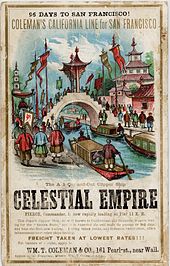

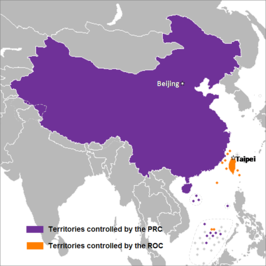



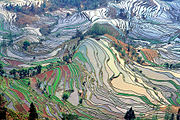

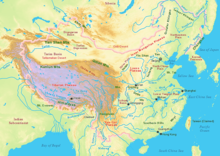







I feel happy to post a comment on this blog, Its really very nice blog thanks for sharing this stuff Army Bharti UP
ReplyDelete